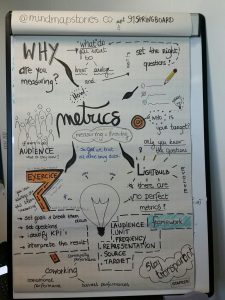At the most recent Coworking Europe conference, which took place in Brussels in November of last year, Anil George, Head of Operations at 91Springboard, India’s largest Coworking network, facilitated a masterclass on how Coworking spaces measure their business performance.
Here is a sum up of the workshop.
 1. Determine the right metrics and indicators
1. Determine the right metrics and indicators
Coworking spaces, like any other businesses, need to measure and quantify performance progress based on defined targets and goals based on various activities. One must consider KPIs (Key Performing Indicators) specific to running a coworking space.
Those metrics will have to be customized according to each activity related to the coworking operations.
We also need to ensure that KPIs are readable, as well as standardized and automated so that everyone can clearly understand these changes.
But first, let’s make sure we first have paid attention on the following things :
- Frequency of the action which is measured (daily, monthly, quarterly, etc)
- Unit used (numbers, currency %, etc)
- Source (such as sales CRM, or a software management tool like Essensys)
- Checklist, dashboard, etc; the audience (team or organisation)
- Target; and how we represent and interpret the final result.
2. Measure the coworking business performances
During the devising metrics masterclass of 91Springboard in Brussels, the participating group worked as one Coworking Space provider with multiple departments and arrived at different conclusions based on various metrics.
Key indicators were used as a way to measure activity in their departments and improve overall performance.
Here are three fields of measurement we can elaborate on : Operational performance, Business performance and Community performance.
A. Operational Performance
 We refer to those items around the regular day-to-day running of the coworking space : efficiency, smooth processes that continually improve with the help of reviewing relevant data…
We refer to those items around the regular day-to-day running of the coworking space : efficiency, smooth processes that continually improve with the help of reviewing relevant data…
Take the example of bandwidth management. What can be done to measure patterns of consumption ?
Example :
- Create utilisation patterns across the day for different types of users
- Do the same by weeks
- Introduce a metric to understand the bandwidth consumption during events
- Etc.
By groing through this, we will able to cater the best possible solutions for upgrades, downgrades and improved infrastructure (access points, router etc) as a whole.
Another example, more focused on qualitative inputs, is : “Good Resolution” by the team running the place.
This can be measured in terms of the number of support tickets for problem-solving, resolution time to close, the sentiment of members after closure and so on.
The overall idea of these operational metrics is to improve the running of the space by going deeper into each one of these elements.
B. Business Performance
The space and its business models must make unit economics sense, for sustainability and scale.
First and foremost, one needs to design the right metrics to provide with the right assessment. Thos metrics might be :
- Revenue per square meter
- Revenue per member
- Revenue per workstation
- Sales conversion ratios
- Cost per lead
- More
It speaks for itself that those are various measures to be reviewed on daily, weekly, monthly, quarterly bais would one want to learn from what’s happening with respect to the business performance, and how he/she stands against our predictions/forecast.
So many proxy metrics of capacity utilization, occupancy, churn serve as second-level/dive-deeper metrics that links back to the root metrics of revenues and expenses.
C. Community Performance
Community is a core element of the why we all love coworking. The idea of creating unique communities that are defined and created by the members for members, which is facilitated by the space providers.
We can improve and measure the internal community dynamic, the external community dynamic, as well as the level of performance regarding events management.
Here are some quantitative and qualitative metrics that can be used to assess the level of engagement of a coworking community:
- Surveys, to deem members’ satisfaction
- Synergies and collaborative projects between members
- Connections and friendships
- Success stories
- Event attendance
- Quality of event feedbacks
- Event attendance patterns
- Etc
Understanding values, beliefs, character, and goals of the space, metrics, which vary from one space to another.
Tracking metrics in a systematic way will develop unique insights, which will make room for new metrics to evolve.
Overall, it will help to draft strategic goals, which can be broken down into more metrics that will answer questions related to personal needs.
Perfect metrics do not exist. However, based on his/her experiences and goals, space managers will find the best metrics that work for them.
Download 91Springboard Metrics presentation :
[sdfile url=”https://socialworkplaces.com/wp-content/uploads/2017/03/24Coworking-Performance_Workshop.pdf” title=”Download 91sprongboard Performance Metrics presentation”]
Join Coworking Europe Conference for more insights, data and connections!




0 Comments